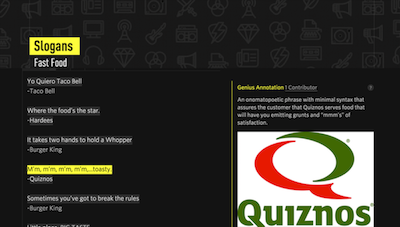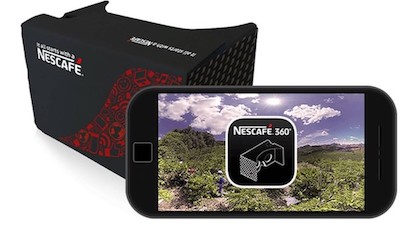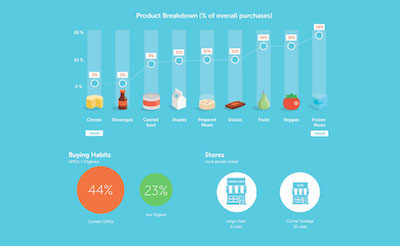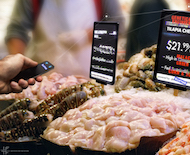Future Now
The IFTF Blog
Food Innovation Recipes: REWRITABLE NARRATIVE
Some recipes are passed down from generation to generation, becoming long-standing traditions. Others invite us to explore new regions or inspire us to reinvent our bodies. They even encourage us to reimagine the food spaces in our lives, from our kitchens to our marketplaces. The power of recipes is the power to combine ingredients in novel ways.
 As we look at the complex global threats we face over the coming decade, from environmental disasters to income inequality to political conflict, we must consider what Institute for the Future calls ingredients for change—capacities, tools, and platforms to reinvent food experiences with the greatest potential for transformation.
As we look at the complex global threats we face over the coming decade, from environmental disasters to income inequality to political conflict, we must consider what Institute for the Future calls ingredients for change—capacities, tools, and platforms to reinvent food experiences with the greatest potential for transformation.
This post gives an overview of one of these ingredients: rewritable narrative. Read more about all five in our forecast report, Food Innovation: Recipes for the Next Decade.
REWRITABLE NARRATIVES:
Toward open food stories
Food narratives are the stories we tell around food—recounting its history and its place within culture, and embodied in its preparation, presentation, and marketing. Narrative has always been an important part of the food experience, shaping its value, and story is clearly a critical tool in selling food products. Increasingly, food purveyors are seeing the experience and narrative of food as core to their offerings—and sometimes the only way to differentiate one food product from another.
Food narratives shift and evolve, but recently we’ve seen the pace of change accelerate and the voices that have a say proliferate. Large food companies and governments used to have an outsized role in the stories we tell about food. But we’re moving from a world in which those stories can remain comparatively fixed toward a world of more open food narratives. In this world, stories move faster; they go through more devices and channels, more storytellers, and more iterations. Over the next decade, no one entity will be able to craft a food story and expect it to remain unchanged.
In the past, a story would be broadcast on a limited number of channels and print outlets. Today, once a story breaks, it can spread around the world in minutes through social media, being modified, adapted, and remixed by the countless people sharing it. And going forward this will only be truer. New communication platforms will be even more open and participatory than the social media of today. Communication devices will be more numerous—from at-a-glance wearables to immersive virtual reality simulations—and in many cases will generate new materials with which people can tell and remix stories. The data individuals will gather through wearable sensors will be used to create and rewrite food stories on the individual, community, and planetary levels.
By 2025, expect people to leverage new platforms and data to tell new food stories, challenge existing ones, and catalyze conversations around food issues that matter to them. Participating in and cultivating these open food narratives has the potential to inspire new channels for more authentic relationships between brands and people.
We’ve developed three forecasts for how rewritable narrative will unfold as an ingredient for innovation in the next decade, with signals of change from today.
FORECAST: new remixers
From broadcast to participatory storytelling
Today, spaces for consuming stories and for discussing them are for the most part segregated. People watch a show on broadcast television and offer live commentary on Twitter. Most websites have a comments section, but it appears at the bottom of the page. In contrast, Wikipedia is editable by anyone, and Japanese video-sharing website Niconico lets commenters place text directly over videos. These sites are hotspots of collaborative remixing; narratives evolve and shift as many people create them together. Going forward, the advent of augmented reality will allow people to add a layer of digital graffiti onto anything in the physical world, and augmented intelligence will make modifying video easier than ever before.
We can see these possibilities through the lens of several signals:
- Signal: Niconico is a Japanese video-sharing website that displays comments, often subtitles or lyrics, directly onto videos as they play. Users can add new comments or respond to others—creating a conversation that unfolds as more people watch the video. Many videos are popular as much for the comments overlaid on them as for the video content itself.
 Signal: Genius, a site dedicated to crowd- sourced annotation of music lyrics, provides a web browser plug-in that lets anyone add annotations to any web page. The service has been used to annotate fast food chain menus and popular products’ nutrition labels—with Mario Batali and Joe Bastianich even used the platform to annotate the menu at their own restaurant, La Sirena. This In the physical world, “culture jammers” have long modified big companies’ billboards and other advertisements to tell new stories. This opens up similar storytelling spaces in the digital world to such remixing.
Signal: Genius, a site dedicated to crowd- sourced annotation of music lyrics, provides a web browser plug-in that lets anyone add annotations to any web page. The service has been used to annotate fast food chain menus and popular products’ nutrition labels—with Mario Batali and Joe Bastianich even used the platform to annotate the menu at their own restaurant, La Sirena. This In the physical world, “culture jammers” have long modified big companies’ billboards and other advertisements to tell new stories. This opens up similar storytelling spaces in the digital world to such remixing.
- Signal: Culture jammers recently set up fake social media accounts to impersonate customer service representatives for two large food companies, Frito-Lay and Campbell Soup Company, to defend the companies against complaints about their LGBT-friendly products or marketing. This shows that if a food producer genuinely connects with people around issues they care about, it can leverage remixers to extend its stories in positive ways.
FORECAST: new mediums
From static surfaces to paintable canvases
In a future where everything has become media—with computing power and Internet connectivity embedded in everything from human bodies to vehicles to the tools and surfaces of our kitchens—we will be able to write and rewrite stories on any surface. People have always used food arrangement and ambience as ways to tell food stories. But with the advent of programmable lighting, augmented reality, and other communications technology, we’ll be able to change the aesthetics of food and the environment it is presented in with much less effort. When manipulating the sensory environment becomes as easy as downloading an app, we’ll see many more people rewriting the narratives of food in this way.
Some examples of how new mediums are being used to create food experiences include:
- Signal: The Philips Hue lighting system uses Wi-Fi-connected light bulbs to let users manipulate the appearance of a given environment with a smartphone app. We’re already seeing food photographers use the Philips Hue system to make food appear more attractive, and they are sharing these techniques with each other online. As technology makes creative food presentation effortless, expect many more people to participate, particularly to reinforce an identity or express creativity.

- Signal: Nescafé and Google teamed up to create a VR experience of travelling to a coffee farm in Brazil that works via an app on the user’s phone. This kind of multisensory technology can make narratives about foods and food experiences— wherever they might be—available to many more people.
- Signal: In a study reported in the Archives of Pediatrics and Adolescent Medicine, children chose an apple with a sticker of the cartoon character Elmo on it over a cookie. This study hints that food aesthetics can be used to nudge people toward particular choices, something large companies have long understood and leveraged. When everything becomes media, people will write new food narratives, even on foods themselves, to encourage healthy choices or reinforce identities or ethics.
FORECAST: new evidence
From science- and marketing-based stories to sensor-based narratives
Stories from countless sources, ranging from scientific research reports to glossy advertisements, tell us how food impacts our bodies and minds. But going forward, we’re going to see an important new source of information emerge: sensor data. As powerful and accessible sensors in, on, and around us quantify anything and everything, we’ll use the data to tell new stories about how we interact with food. New food narratives will proliferate, and they’ll be much more varied and idiosyncratic than before. People will be able to track how food impacts them as individuals, new a nity groups will emerge, and communities will be able to draw new connections between food and outcomes they find desirable.
The signals below are early examples of the ways people are creating and utilizing new forms of evidence to create their own food narratives today:
- Signal: Bulletproof Coffee, a recipe invented by Dave Asprey through self-experimentation, blends coffee with butter to boost cognitive function. This recipe is associated with the quantified self movement— people tracking metrics about themselves over time to uncover patterns and gain insight into how their bodies and minds work. Going forward, as sensors make such experimentation much easier, expect more food narratives to be rewritten through self-study.
 Signal: Wrap Genius, an enhanced digital food labeling framework, was developed by NYU graduate student Sam Slover. Slover tracked his grocery purchases for three months and came up a visual framework for understanding and telling his personal food story, such as the number of ingredients consumed and how far the foods had traveled. New tools will let us automatically track and display this kind of data in visual, personal food narratives with actionable information.
Signal: Wrap Genius, an enhanced digital food labeling framework, was developed by NYU graduate student Sam Slover. Slover tracked his grocery purchases for three months and came up a visual framework for understanding and telling his personal food story, such as the number of ingredients consumed and how far the foods had traveled. New tools will let us automatically track and display this kind of data in visual, personal food narratives with actionable information.
- Signal: A study by Alia Crum at Columbia University found that food labels affected people’s levels of ghrelin, a hormone associated with satiety. Two groups of people drank the same milkshake, for one group labeled as a high-calorie indulgent shake, for the other a low-calorie health shake—and those who drank the latter shake actually produced less ghrelin. Labels evoke beliefs, and these beliefs matter in the complex interactions among story, food, bodies, and minds.
 ARTIFACT FROM THE FUTURE: Surface Hackers
ARTIFACT FROM THE FUTURE: Surface Hackers
This particular Artifact from the Future might be something you would see over the coming decade as Rewritable Narrative revolutionizes the food system. Read about what this image to the right is, and what it means for the future.
HOW WILL YOU CATALYZE FOOD INNOVATION?
Read all of the forecasts and foresight tools in our report, Food Innovation: Recipes for the Next Decade. It explores rewritable narrative and four other ingredients for change—capacities, tools, and platforms to reinvent food experiences with the greatest potential for transformation.

For More Information
For more information on the Food Futures Lab and its research, contact:
Rebecca Chesney | rchesney@iftf.org



